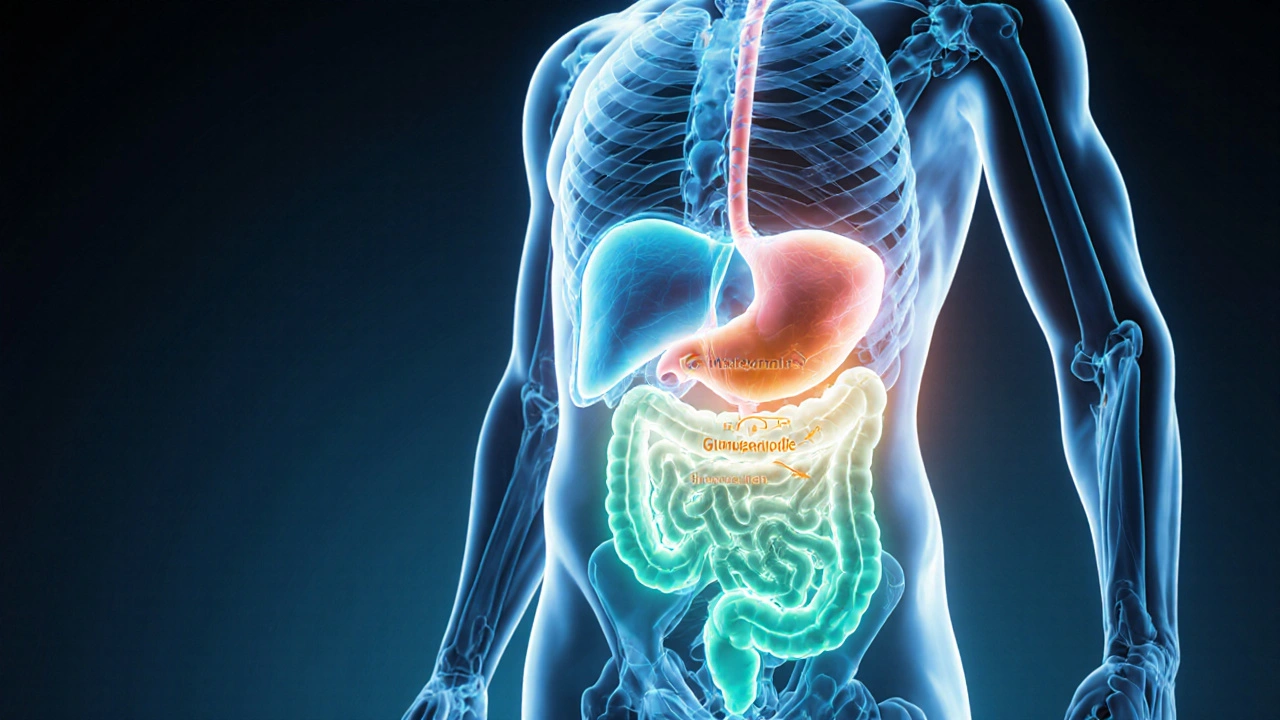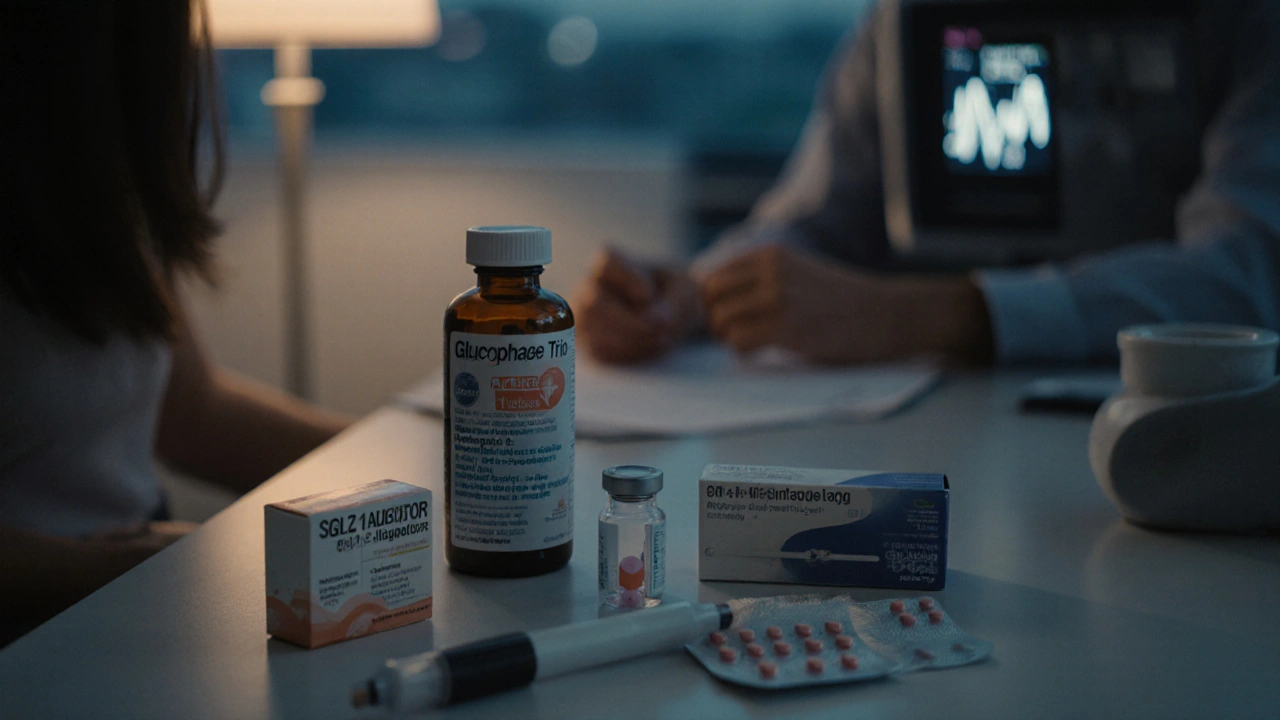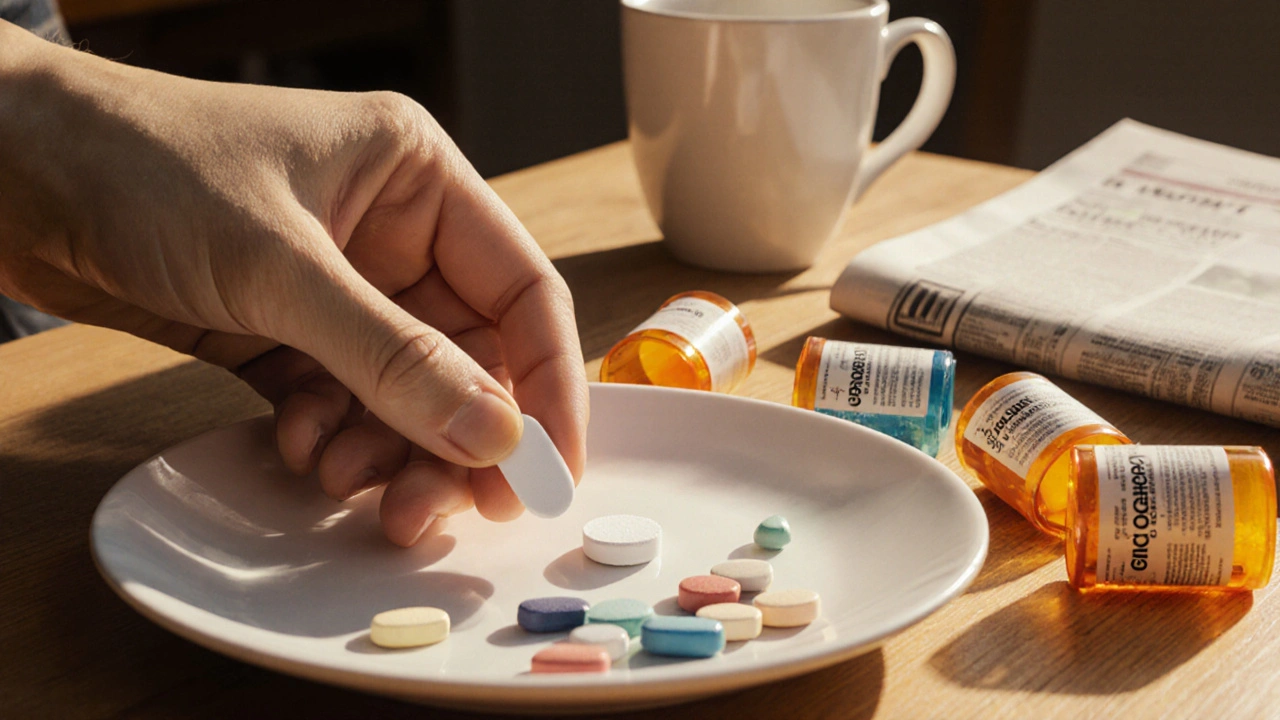Diabetes Medication Selector
Your Diabetes Treatment Preferences
Answer a few questions to get personalized recommendations for your diabetes management.
Select your preferences above and click "Get Recommendations" to see personalized options.
Key Takeaways
- Glucophage Trio combines three agents that target glucose production, insulin release, and carbohydrate absorption.
- Its main rivals are single‑agent DPP‑4 inhibitors, SGLT2 blockers, GLP‑1 agonists, and older sulfonylureas.
- Choose Glucophage Trio when you need a low‑cost, once‑daily regimen and can tolerate mild GI upset.
- Consider alternatives if you prioritize weight loss, lower hypoglycemia risk, or have renal limitations.
- Regular monitoring of blood sugar, kidney function, and liver enzymes is essential for any regimen.
Managing Type 2 Diabetes often feels like juggling several pills, each with its own schedule and side‑effects. Glucophage Trio is marketed as a single tablet that packs three drugs-Glimepiride, Metformin, and Voglibose-into one dose. The promise is simple: fewer pills, steadier control, and a price tag that doesn’t break the bank.
But the market is crowded. Newer agents promise weight loss, cardiovascular protection, or a lower chance of low blood sugar. If you’re weighing Glucophage Trio against those options, you need a clear picture of how each works, who benefits most, and what the trade‑offs are. This guide breaks down the trio, lines it up against popular alternatives, and gives practical tips for choosing the right plan.
What is Glucophage Trio?
Glucophage Trio is a fixed‑dose combination tablet that contains three active ingredients:
- Glimepiride - a second‑generation sulfonylurea that stimulates pancreatic β‑cells to release more insulin.
- Metformin - a biguanide that lowers hepatic glucose production and improves peripheral insulin sensitivity.
- Voglibose - an α‑glucosidase inhibitor that slows carbohydrate breakdown in the gut, reducing post‑meal glucose spikes.
Each component tackles a different part of the glucose‑control puzzle, so the combination can deliver a broader effect than any single drug alone. The tablet comes in a 500mg Metformin / 2mg Glimepiride / 0.2mg Voglibose strength, taken once daily with breakfast.
How the three ingredients work together
Glimepiride works fast-within 30minutes-by binding to the sulfonylurea receptor on β‑cells, prompting insulin release. This helps lower fasting glucose but also raises the risk of hypoglycemia, especially if meals are missed.
Metformin has a slower onset but a strong safety record. It reduces liver output of glucose and makes muscle cells more responsive to insulin. The biggest side‑effects are mild stomach upset and, rarely, vitaminB12 deficiency.
Voglibose acts locally in the intestine, delaying the breakdown of starches and sugars. It blunts the post‑prandial surge without causing systemic hypoglycemia. The downside is flatulence and occasional diarrhea.
When you combine them, Metformin handles the baseline, Glimepiride spikes insulin when needed, and Voglibose smooths the meal‑time peaks. The synergy can lower HbA1c by 1.5-2.0% in many patients, according to a 2023 real‑world study of 4,200 adults on the trio.

Popular alternatives to consider
Manufacturers have rolled out several single‑agent or dual‑agent options that target similar pathways but with different safety profiles.
- Sitagliptin (DPP‑4 inhibitor) - modest HbA1c reduction, weight neutral, low hypoglycemia risk.
- Empagliflozin (SGLT2 inhibitor) - reduces glucose reabsorption in kidneys, promotes weight loss, offers heart‑failure benefits.
- Liraglutide (GLP‑1 receptor agonist) - powerful HbA1c drop, weight loss, but requires injectable administration.
- Pioglitazone (thiazolidinedione) - improves insulin sensitivity, but can cause fluid retention and weight gain.
- Glyburide - an older sulfonylurea similar to Glimepiride but with higher hypoglycemia risk.
Side‑by‑side comparison
| Attribute | Glucophage Trio | Sitagliptin (Januvia) | Empagliflozin (Jardiance) | Liraglutide (Victoza) | Pioglitazone (Actos) |
|---|---|---|---|---|---|
| Primary Mechanism | Sulfonylurea+biguanide+α‑glucosidase inhibition | DPP‑4 inhibition - increases incretin levels | SGLT2 inhibition - blocks renal glucose reabsorption | GLP‑1 receptor activation - enhances insulin, slows gastric emptying | PPAR‑γ activation - improves peripheral insulin sensitivity |
| Dosage Form | Oral tablet, once daily | Oral tablet, once daily | Oral tablet, once daily | Subcutaneous injection, daily | Oral tablet, once daily |
| Typical HbA1c Reduction | 1.5-2.0% | 0.5-0.8% | 0.7-1.0% | 1.0-1.5% | 0.5-0.8% |
| Weight Impact | Neutral to slight gain | Neutral | Modest loss (≈2kg) | Loss (≈3-5kg) | Gain (≈2kg) |
| Hypoglycemia Risk | Moderate (mainly from Glimepiride) | Low | Low | Low | Low |
| Common Side‑effects | GI upset, flatulence, occasional low blood sugar | Headache, nasopharyngitis | UTI, genital mycotic infection, mild dehydration | Nausea, vomiting, possible pancreatitis | Edema, weight gain, risk of heart failure |
| Average Monthly Cost (US) | $30-$45 | $45-$60 | $120-$150 | $400-$500 (injectable) | $70-$90 |
The table makes the trade‑offs crystal clear. Glucophage Trio wins on price and the breadth of mechanisms, but it carries a higher hypoglycemia risk because of the sulfonylurea component. If you’re cost‑sensitive and can monitor glucose closely, the trio can be a solid starter.
When Glucophage Trio may be the right choice
- Newly diagnosed patients whose HbA1c is 7-9% and who need a quick drop.
- Individuals without significant kidney or liver disease (eGFR≥60mL/min/1.73m², normal liver enzymes).
- Those who prefer an oral regimen over injectables.
- Budget‑conscious patients or those with limited insurance coverage.

Scenarios where an alternative shines
- Patients at high risk of hypoglycemia (elderly, shift workers, those with unpredictable meals) - SGLT2 inhibitors or DPP‑4 inhibitors are safer.
- People needing weight loss - GLP‑1 agonists or SGLT2 blockers deliver consistent reductions.
- Patients with established cardiovascular disease - Empagliflozin has proven heart‑failure benefits that the trio lacks.
- Renal impairment (eGFR<45) - Metformin dose must be reduced; SGLT2 inhibitors may be contraindicated, making DPP‑4 inhibitors a practical fallback.
Practical tips for using Glucophage Trio
- Start with a half‑tablet for the first week if you’re sensitive to GI effects; titrate up to a full tablet.
- Take it with a substantial breakfast to blunt the sulfonylurea‑induced hypoglycemia.
- Check fasting glucose each morning for the first two weeks; adjust if values fall below 70mg/dL.
- Monitor creatinine and liver enzymes every three months; halt if ALT exceeds three times the upper limit.
- Educate patients on recognizing low‑blood‑sugar symptoms and carrying quick‑acting carbs.
Common pitfalls and how to avoid them
- Skipping meals while on the trio can trigger dangerous lows. Reinforce the “take with food” rule.
- Assuming the trio replaces lifestyle changes. Diet, exercise, and weight management still drive long‑term success.
- Using the combo in severe renal failure - Metformin accumulates, raising lactic‑acid risk.
- Neglecting regular HbA1c checks. Aim for a test every three months to confirm the regimen meets targets.
Frequently Asked Questions
Can I take Glucophage Trio if I have a history of heart disease?
The trio does not have proven cardiovascular benefits like some SGLT2 inhibitors. If you have established heart disease, discuss adding an agent such as Empagliflozin or a GLP‑1 agonist alongside the combo, or consider switching entirely.
What should I do if I experience frequent low blood sugar?
First, check whether you’re skipping or delaying meals. If meals are regular, ask your doctor to lower the Glimepiride dose, switch to a lower‑risk sulfonylurea, or add a DPP‑4 inhibitor that doesn’t cause hypoglycemia.
Is the trio safe for people over 70 years old?
Older adults often have reduced kidney function and are more prone to hypoglycemia. If eGFR is above 60 and you can monitor glucose closely, the trio can be used at a reduced dose, but many clinicians prefer a sulfonylurea‑free regimen for this age group.
How does Voglibose differ from other α‑glucosidase inhibitors like Acarbose?
Voglibose is more potent at lower doses and tends to cause less severe diarrhea than Acarbose, but both share the same mechanism of delaying carbohydrate digestion. Choice often depends on cost and patient tolerance.
Can I combine the trio with a SGLT2 inhibitor?
Yes, many clinicians add Empagliflozin to enhance glucose control and add cardiovascular protection. Monitor for dehydration and adjust diuretic doses if needed.


The cost advantage of the Glucophage Trio is undeniable, especially for patients without comprehensive insurance coverage. However, the inclusion of a sulfonylurea inherently raises the risk of hypoglycemia, which cannot be overlooked in any clinical assessment.
sure,, the price is low but,, the risk is high,, you cant ignore it
In the grand tapestry of therapeutic choices, one must weigh not merely monetary metrics but the existential burden of recurrent lows that haunt the diabetic soul. The paradox lies in trading a modest wallet for a volatile glucose rhythm.
I find the table easy to read. It shows clearly when the trio is worth trying.
What the mainstream pharmaco‑marketing fails to disclose is the hidden agenda of conglomerates pushing multi‑agent pills to lock patients into perpetual consumption cycles, masking subtle nephrotoxic signals behind glossy cost‑saving headlines.
Hey, that's a solid point-looking beyond the price tag helps everyone make a smarter choice.
Budget-friendly, oral, but watch for lows.
Budget‑friendly is correct; oral is correct; however, the phrase “watch for lows” should be “watch for hypoglycemia episodes.”
Anyone ignoring the moderate hypoglycemia risk is basically endorsing danger; the data are crystal clear.
Dangerous data ignored
When choosing a regimen, consider not just HbA1c reduction but also your lifestyle, meal patterns, and ability to monitor glucose regularly.
Exactly, balance is key for sustainable control.
The trio's GI side effects, like bloating and cramping, are often underreported, so patients should be advised to start low dose and titrate slowly.
Also, if you're on any blood pressure meds, watch for an unexpected dip in potassium when combining with this combo.
Glucophage Trio presents a compelling value proposition for many patients navigating the labyrinth of type‑2 diabetes management. Its triple‑mechanism approach attacks fasting glucose, post‑prandial spikes, and insulin resistance all at once, which can translate into a respectable HbA1c drop of around 1.5‑2 percent. The once‑daily oral dosing simplifies adherence compared to injectable GLP‑1 agonists, which can be a decisive factor for those averse to needles. Moreover, the monthly cost, typically hovering between thirty and forty‑five dollars, fits comfortably within the budgets of most insurance plans or cash‑pay patients. However, the inclusion of glimepiride introduces a moderate risk of hypoglycemia that cannot be dismissed, especially in the elderly or those with unpredictable meal schedules. Gastro‑intestinal discomfort from metformin and flatulence from voglibose also demand a gradual titration strategy to improve tolerability. For patients with preserved renal function (eGFR ≥ 60 mL/min/1.73 m²), the trio can be used safely, but caution is advised when kidney function declines. The combination does not confer the cardiovascular benefits demonstrated by SGLT2 inhibitors such as empagliflozin, which may be a critical consideration for individuals with existing heart disease. Weight impact remains largely neutral, making it less attractive for those actively seeking weight loss. On the other hand, the neutral weight profile may be preferable for patients concerned about weight gain from other agents like pioglitazone. Cost‑sensitivity, drug‑interaction potential, and patient preferences should collectively guide the final decision. Regular monitoring of blood glucose, renal parameters, and liver enzymes is essential regardless of the chosen therapy. Shared decision‑making with a healthcare provider ensures that the selected regimen aligns with clinical goals and personal circumstances. In summary, the trio shines when affordability and simplicity are paramount, but alternatives may outrank it for patients prioritizing cardiovascular protection or weight reduction. Ultimately, personalized medicine, not a one‑size‑fits‑all, determines the optimal path forward.
Wow, a masterclass in clinical minutiae-next we’ll be prescribing based on the orbital mechanics of insulin receptors.
Incredible!!! This guide blows the roof off the usual diabetes discussion!!!!!!
Sure it’s thorough but most people just want a quick answer
Thanks for breaking it down so clearly, really helps me feel more confident about my next appointment!